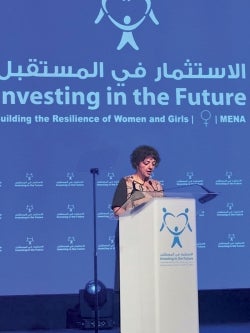BEYOND THEIR NATURAL BEAUTY, the wetlands along the Pacific and other coastal regions serve valuable purposes for animals and humans alike. Ecologically, they provide a natural habitat for wildlife, including many endangered species and commercial fish. Less appreciated is their public health and environmental protection role — from filtering our water to buffering coastal communities against the effects of storm surges and flooding.
UCLA’S SUSTAINABLE LA GRAND CHALLENGE aims to lead Los Angeles County into a future in which it obtains all of its energy from renewable resources by 2050 — a transition viewed as essential to the effort to slow the effects of climate change. And if any more incentive to fulfill the ambitious target is needed, a Fielding School-led study underway as part of the Grand Challenge will lay out the significant public health gains that are expected to result from replacing conventional fossil fuels with renewable energy.
THE CAMP FIRE that started on November 8, 2018 in Northern California’s Butte County burned through more than 150,000 acres and destroyed more than 18,000 structures over 17 days. Eighty-five lives were lost, making it the deadliest and most destructive fire in California history. The Woolsey Fire, which started the same day, blazed through nearly 100,000 acres in Los Angeles and Ventura counties, destroying more than 1,600 structures and forcing the evacuation of nearly 300,000 people.
BACK WHEN HE WAS A GRADUATE STUDENT, Jisung Park concluded that the insufficient urgency in addressing climate change was due in part to the way the issue was depicted.
AS AN EXPERT IN DISASTER PREPAREDNESS AND RESPONSE whose work has increasingly focused on the weather events that are occurring with growing intensity and frequency as the climate changes, Dr. David Eisenman has observed that one type of natural disaster is often overlooked.
CLIMATE CHANGE is already jeopardizing health and well-being in the U.S. and abroad, and is projected to become a greater public health threat in the decades to come. The World Health Organization has outlined some of the key ways in which climate change affects health. As the examples in this issue demonstrate, Fielding School faculty, students and alumni are leading efforts to protect populations against this developing crisis.
As he neared retirement after more than three decades on the UCLA Fielding School faculty, Dr. Gerald Kominski knew what he wanted to leave as part of his legacy.
“Many had lived with fistula for years and had no idea it was a preventable or treatable condition.”
— Lindsey Pollaczek
MORE THAN 1 MILLION WOMEN AND GIRLS in low-income countries live with a condition that makes many of them outcasts in their communities and hinders them from earning a living. The condition is not only preventable but also highly treatable through surgery.
AS A HOSPITAL NURSE AT THE OUTSET OF HER CAREER, Mary Hansell (MPH ’83, DrPH ’89) was quickly drawn to the obstetrics unit. “It was exciting to me to work with people as they prepared to become parents, feeling like I could make a difference in supporting them,” she says. That was when Hansell also began to appreciate the importance of prevention and addressing societal factors to ensure planned pregnancies, appropriate prenatal care, healthy births and positive life trajectories for parents and children.
At WHO we don’t look at human rights, equity or gender in isolation, but rather through an integrated framework.”
— Dr. Veronica Magar

Dr. Veronica Magar (MPH '91)